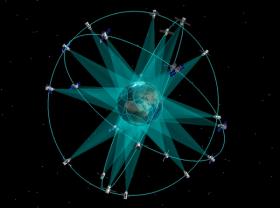The next GLONASS satellite with dose radiometer developed by the SINP scientists was successfully launched from the Plesetsk launching site on March 24.
Dose radiometers measure space radiation onboard satellites of GLONASS orbital constellation already for 8 years. Currently they are set on the most of the GLONASS satellites (totally the GLONASS group consists of 24 spacecrafts). The altitude of the circular orbits of the satellites is about 20 thousands kilometers, inclination of the orbital plane to the equatorial plane is 65 degrees. They cross the core of the external radiation belt of the Earth and scan the area of the maximum intensity of the radiation flux four times per day. The spacecrafts spend about half-time in space regions, where solar cosmic rays penetrate freely under quiet geomagnetic conditions. The scientific equipment onboard the satellites records both absorbed radiation dose and charged particles fluxes from the Earth's radiation belts and generated by the Sun during the solar flares.
It is necessary to provide continuous monitoring of space under natural conditions, because existed radiation models can't forecast unpredictable variations of space radiation, which can influence onboard systems negatively due to extreme high values. Long-term measurements provided simultaneously onboard several GLONASS satellites in different points allow compiling of a database in order to improve radiation models for this orbit. Radiation conditions at the GLONASS orbit were analyzed basing on the records of the dose radiometer during 2007-2013.
As the Leading researcher of the Department of Theoretical and Appled Space Physics (DTASP), PhD. Vladimir Tulupov told us: "We managed to compile a rather complete chain of measurements, including abnormal solar activity minimum at the ened of the 23d solar cycle. Generally the amplitude of the electron flux variation is in good agreeement with radiation dose. It is interesting, that especially in 2012 there were observed significant variations of dayly averaged radiation dose and relativistic electrons flux, up to 1.5-2 orders of magnitude. A seasonal variation was also observed, moreover winter dips are the most noticeable. Comparing the data with the model of the external radiation belt AE-8 it was shown that at the GLONASS orbit the total measured radiation level is close to the model evaluations. Only in 2012 measured average annual dose exceeded the level predicted by the model, but not more then two times. But at the deepest point of the unique solar activity minimum (in 2009 and at the beginning of 2010) the radiation dose was found to be dramatically lower (over 10 times) compared to the model. These results lead to the conclusion that the radiation model should be corrected depending on time variation of solar activity."
Then Vladimir Tulupov told us about the instrument. Dose radiometer has a volume of less than 1.5 liters and weight less than 1 kg. It consists of two parts - a dosimeter based on a compact ionization chamber, developed and manufactured by the scientists of the Laboratory of Applied Space Physics of DTASP headed by M.V. Teltsov, and two gas-discharge Geiger-Muller counters industrially produced with necessary electronics. The dosimeter measures absorbed radiation dose produced by different types of ionizing radiation (mainly, by charged particles), which penetrate into it, while the counters detect the values of the particles fluxes independent of the dosimeter.
Gas-discharge counters provide different effective areas for radiation detection in order to measure large flux by one counter when the second is at saturation.
Ionization chamber is a pressurized carrier filled with gas mixture. Under the influence of ionizing radiation electrical charge proportional to the absorbed energy is accumulated in the chamber, and after a certain value of the absorbed dose ("trigger price") is accumulated, a trigger impulse is produced at the output of the chamber, and then chamber is returned to the initial state. Absorbed dose for some time interval is equal to the product of a number of registered impulses and the value of "trigger price".
Trigger impulses of the dosimeter and the gas-discharge counters are accumulated in the instrument, forming a telemtry frame which is transmitted to the GLONASS satellite every 2 minutes. The instrument is provided with an additional (accumulating) channel, to which integral value of the absorbed dose is output once per 30 minutes. The information is transmitted to the Earth by telemetry channels of the satellite.

